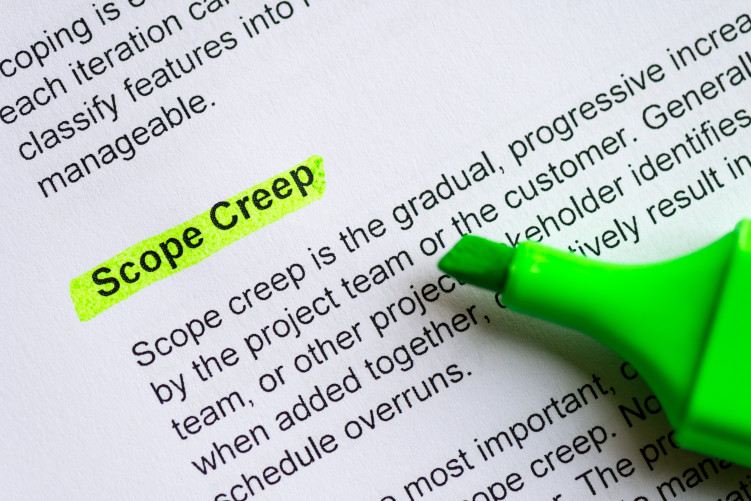Leslie Ciborowski
President Of TrainSmart, Inc.

10 STEPS TO HALT THE SPREAD OF SCOPE CREEP
Let’s face it. Scope creep happens. And all the planning and good intentions in the world will not protect you from that moment when you have to decide whether to allow the creep or crush it.
The real issue is just how creepy it’s going to get and whether you can manage it in a way that allows you to maintain the client relationship (if, when all is said and done, that’s what you want), create a product that you are proud of, and deliver a product that is in the positive column of your profit and loss statement.
When conducting an AAR or After-Action Review, teams often realize that the foundations of scope creep were built before the project began. Here are some steps to avoid “Project Shoulda, Coulda, Woulda.”
Step One – Set Clear Expectations. It’s Amazingly Not Obvious
This seems so basic that it is always embarrassing when we discover (too late) that the real problem was that we were working on a set of assumptions, and the client had a slightly but costly different translation of those assumptions. When a project begins, be sure to set clear, agreed-upon expectations. Make sure those expectations are in writing and that both the client and Subject Matter Expert sign off on them.
We’ve learned that a client’s and SME’s understanding of the expectations can be dramatically different. Getting them on the same page before the project begins may push back the start while they iron out their differences, but that inconvenience is outweighed by making sure the client and SME’s objectives are aligned.
Step Two- Hold a Change Process Conversation
Some changes are just that—changes. Other changes pack the punch of a tsunami. Regardless of its size, someone is going to be unhappy with each change. You can count on that.
Because of the potential damage that changes gone wild can have to the relationship, deadline, pride in the product, and ROI, it’s important to have a meeting devoted exclusively to the change process prior to the project launch. That may feel excessive, and sometimes it’s not realistic, but it is the ideal. It puts the client on alert that you take scope changes very seriously.
Clients may balk at the extra time or necessity to have this meeting, mainly if they have worked with you in the past, but it’s like being a professional athlete who needs to go to spring training camp before the new season. The pros know you have to get in shape before every season. The same is true for every project.
The agenda for the meeting should include:
- Define roles and responsibilities, including sign-off procedures
- Ensure understanding and intent of the Change Request process
- Detail the impacts of change once the process has begun
- Establish tracking and communication processes
Step Three – Sign The Change Process Agreement Document.
Step Four – Track, Report, Repeat Again
It takes skill, discipline, and patience to maintain accurate records of the project status and cost and expense records. That means everyone on the team must be aware and follow the processes to ensure accurate and up-to-date information. One chink in the chain can have the ripple effect of a stone skimming a pond. Throughout the project, clients need to sign off of at critical milestones to document they are aware of the progress, issues, and status of the project.
Step Five – Execute Change Requests
Any time there is a need to deviate from the agreed process, it’s mandatory to execute a Change Request that spells out exactly what the change is and its implications to the deadline and budget. Both the client and consultant need to sign the agreement. Sometimes, just seeing the bottom line implications of a desired change will create enough of a pause for a less dramatic change to be introduced.
STEP SIX, SEVEN, EIGHT, NINE, TEN….
Communicate, Communicate, Communicate!
Conclusion
While scope creep can be a challenging aspect of project management, it doesn’t have to derail your project or damage client relationships. By setting clear expectations, establishing a change process, maintaining accurate records, and prioritizing constant communication, you can confidently navigate the murky waters of scope changes.
Remember, the key is not to eliminate scope creep—that’s often unrealistic—but to manage it effectively. By implementing the steps outlined in this post, you’ll be better equipped to:
- Anticipate potential changes before they occur
- Respond promptly and professionally when changes are requested
- Maintain transparency with your client throughout the project
- Protect your bottom line and the quality of your deliverables
Ultimately, successful project management isn’t about avoiding all challenges—it’s about being prepared to face them head-on. With these strategies in your toolkit, you’ll be ready to turn potential scope creep into collaboration, innovation, and mutual success opportunities.
Stay vigilant, stay communicative, and remember: in the world of project management, forewarned is forearmed. Your future self—and your clients—will thank you for it.